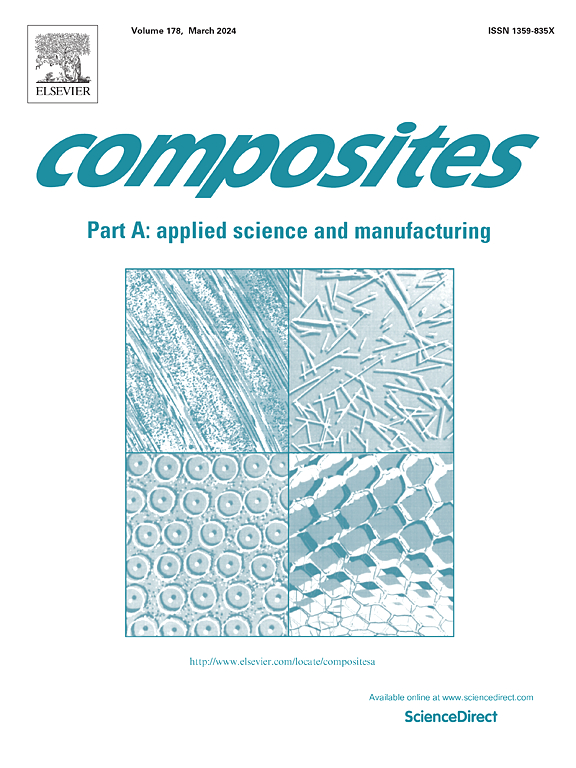通过短流程技术实现 TiB/metastable-β 复合材料的超高强度
IF 8.1
2区 材料科学
Q1 ENGINEERING, MANUFACTURING
Composites Part A: Applied Science and Manufacturing
Pub Date : 2024-10-18
DOI:10.1016/j.compositesa.2024.108522
引用次数: 0
摘要
具有超高强度和合理延展性的轻质钛合金是航空航天应用的理想材料。然而,钛合金通常需要经过繁琐的热处理才能获得优异的机械性能。在这里,通过引入 TiB 晶须,采用短流程(即熔化和等温锻造)制造出了基于 Ti-55531 的超高强度复合材料。通过研究等温锻造过程中的微观结构演变,TiB晶须会促进不连续的动态再结晶并阻碍异常晶粒生长,从而导致显著的β晶粒细化、等轴化和晶体取向随机化。此外,还形成了均匀分布的纳米级 αs薄片。2.5 vol% TiB/Ti-55531 实现了卓越的强度-塑性协同作用,其超高强度为 1525 ± 4 MPa,伸长率为 6.4 %±0.2 %,分别比 Ti-55531 高出 9.2 % 和 12.3 %。对其强化机理进行了深入分析,为通过短流程技术简化超高强度 TMC 的制备和推进其应用提供了更多启示。本文章由计算机程序翻译,如有差异,请以英文原文为准。
Achieving ultra-high strength in TiB/metastable-β composites via short-process technology
Lightweight titanium alloys with ultra-high strength and reasonable ductility are desirable for aerospace applications. However, titanium alloys typically require cumbersome heat treatment to achieve excellent mechanical properties. Here, ultra-high strength Ti-55531-based composites were fabricated by introducing TiB whiskers using a short process, i.e. melting and isothermal forging. The microstructure evolution during isothermal forging was investigated, TiB whiskers would promote the discontinuous dynamic recrystallization and impede abnormal grain growth, resulting in significant β grain refinement, equiaxialization, and crystal orientation randomization. In addition, uniformly distributed nano-scaled αs lamellae were formed. 2.5 vol% TiB/Ti-55531 achieved a superior strength-plasticity synergy with the ultra-high strength of 1525 ± 4 MPa and elongation of 6.4 %±0.2 %, which were 9.2 % and 12.3 % higher than that of Ti-55531, respectively. The strengthening mechanisms were thoroughly analyzed, providing further insight to simplify the preparation and advance the application of ultra-high strength TMCs via short-process technology.
求助全文
通过发布文献求助,成功后即可免费获取论文全文。
去求助
来源期刊

Composites Part A: Applied Science and Manufacturing
工程技术-材料科学:复合
CiteScore
15.20
自引率
5.70%
发文量
492
审稿时长
30 days
期刊介绍:
Composites Part A: Applied Science and Manufacturing is a comprehensive journal that publishes original research papers, review articles, case studies, short communications, and letters covering various aspects of composite materials science and technology. This includes fibrous and particulate reinforcements in polymeric, metallic, and ceramic matrices, as well as 'natural' composites like wood and biological materials. The journal addresses topics such as properties, design, and manufacture of reinforcing fibers and particles, novel architectures and concepts, multifunctional composites, advancements in fabrication and processing, manufacturing science, process modeling, experimental mechanics, microstructural characterization, interfaces, prediction and measurement of mechanical, physical, and chemical behavior, and performance in service. Additionally, articles on economic and commercial aspects, design, and case studies are welcomed. All submissions undergo rigorous peer review to ensure they contribute significantly and innovatively, maintaining high standards for content and presentation. The editorial team aims to expedite the review process for prompt publication.
 求助内容:
求助内容: 应助结果提醒方式:
应助结果提醒方式:


